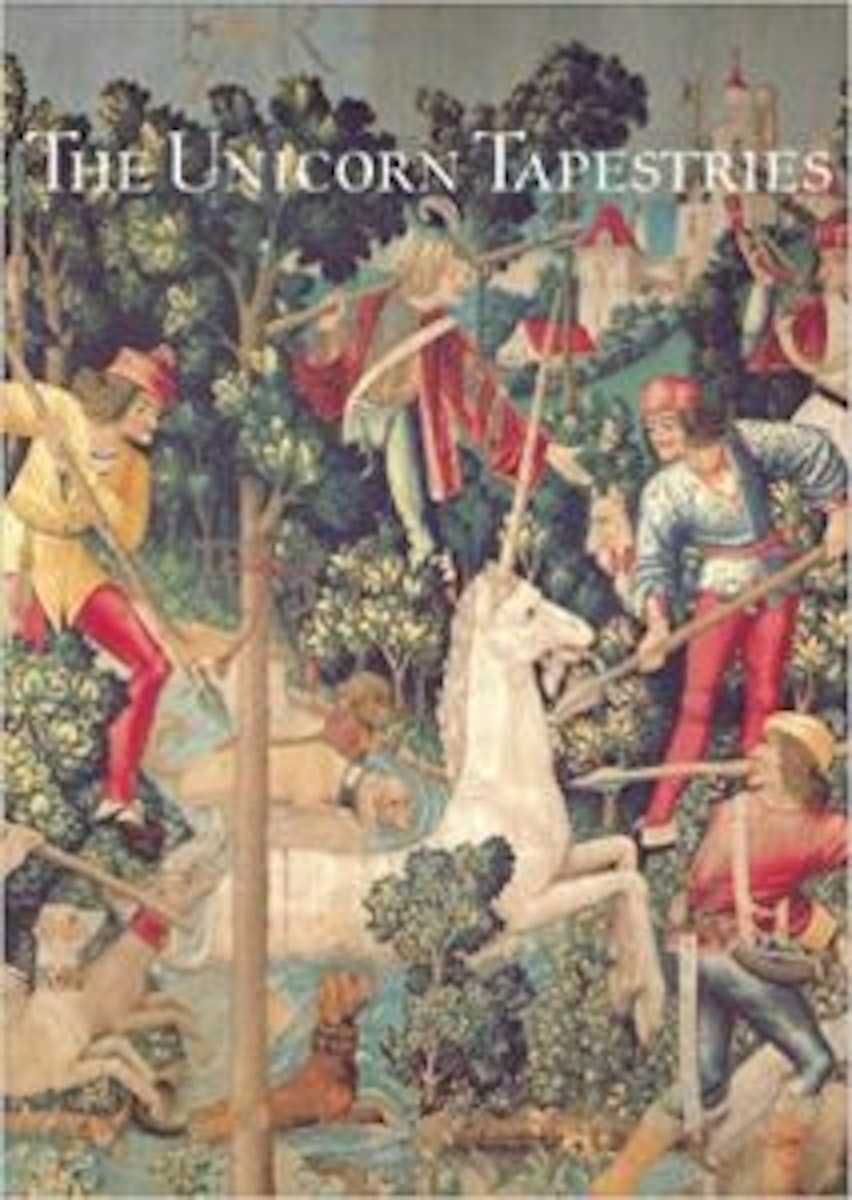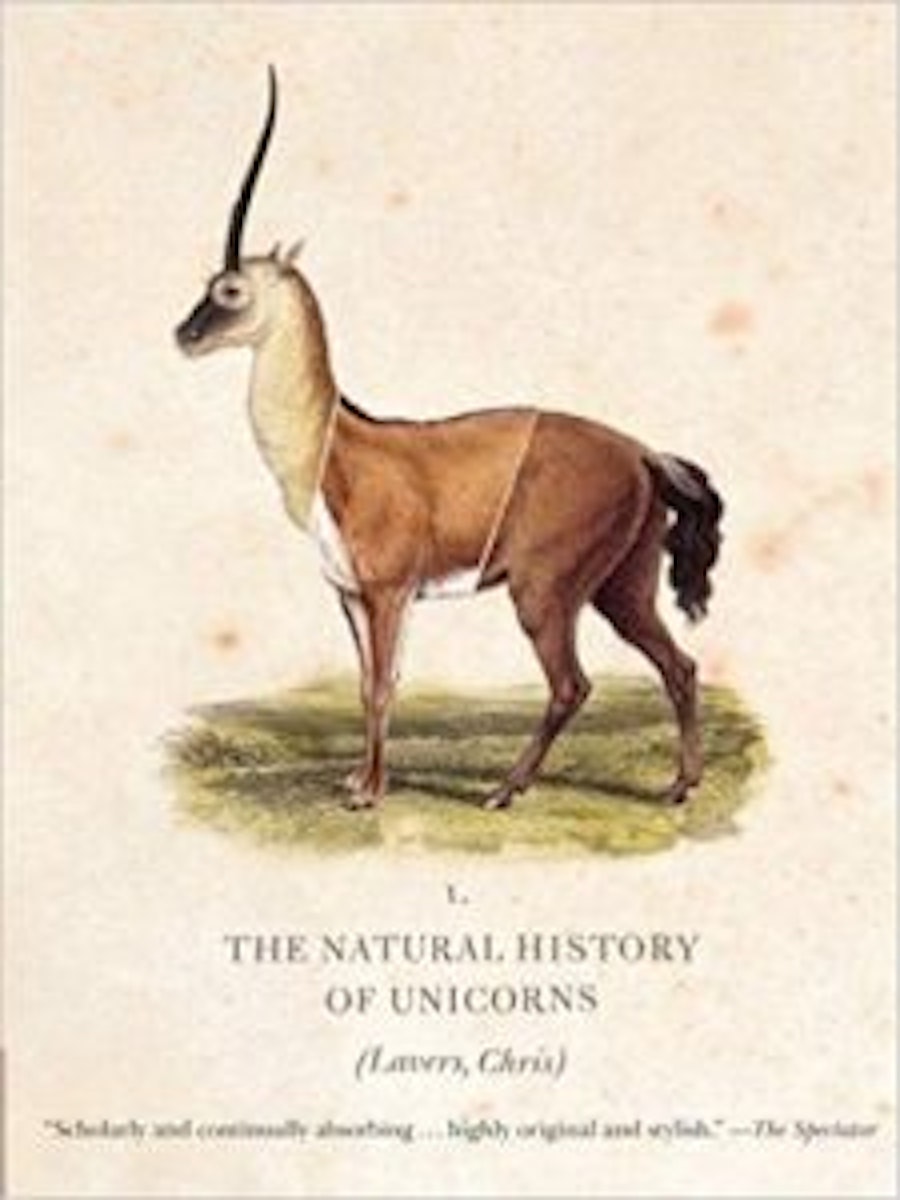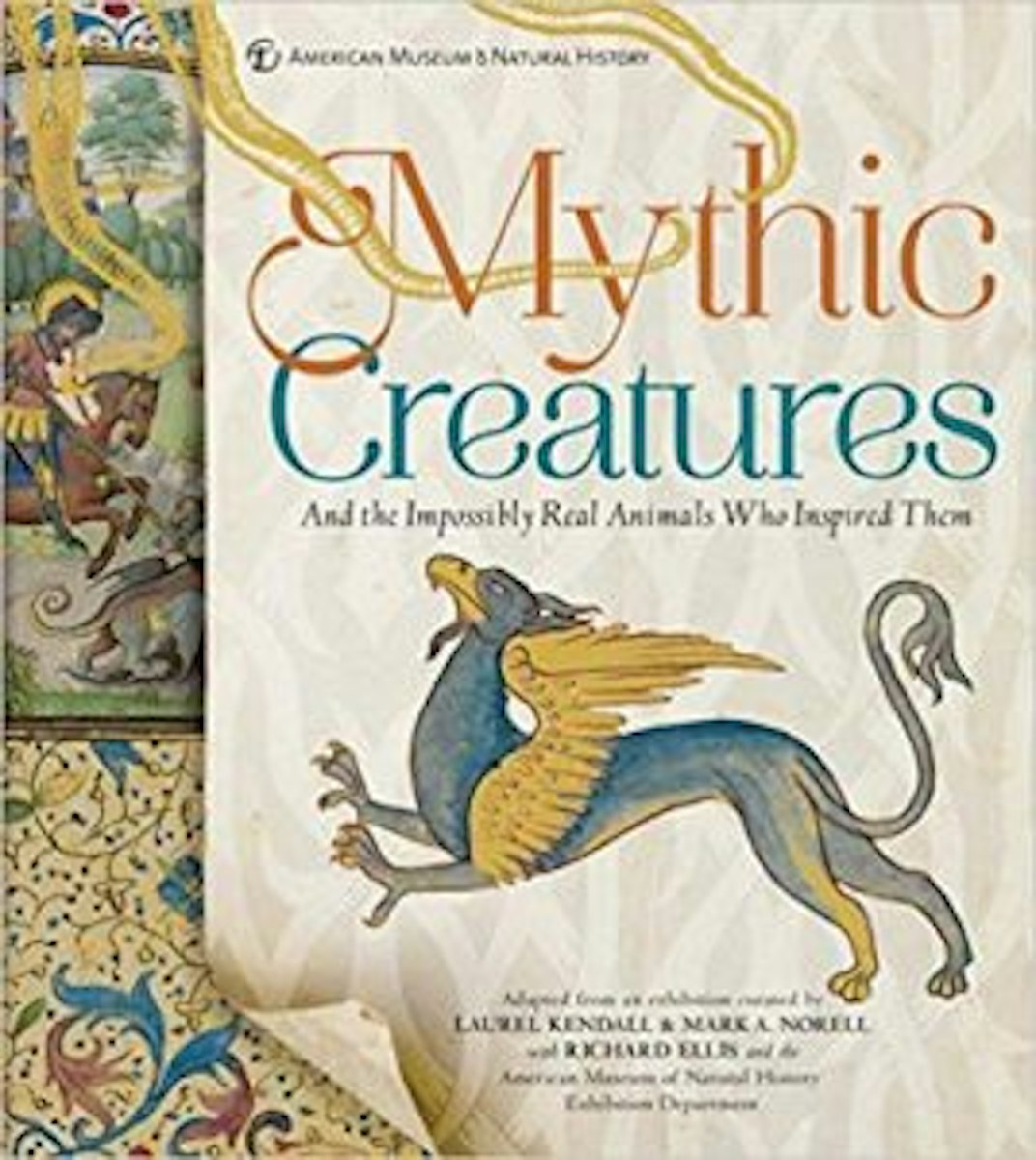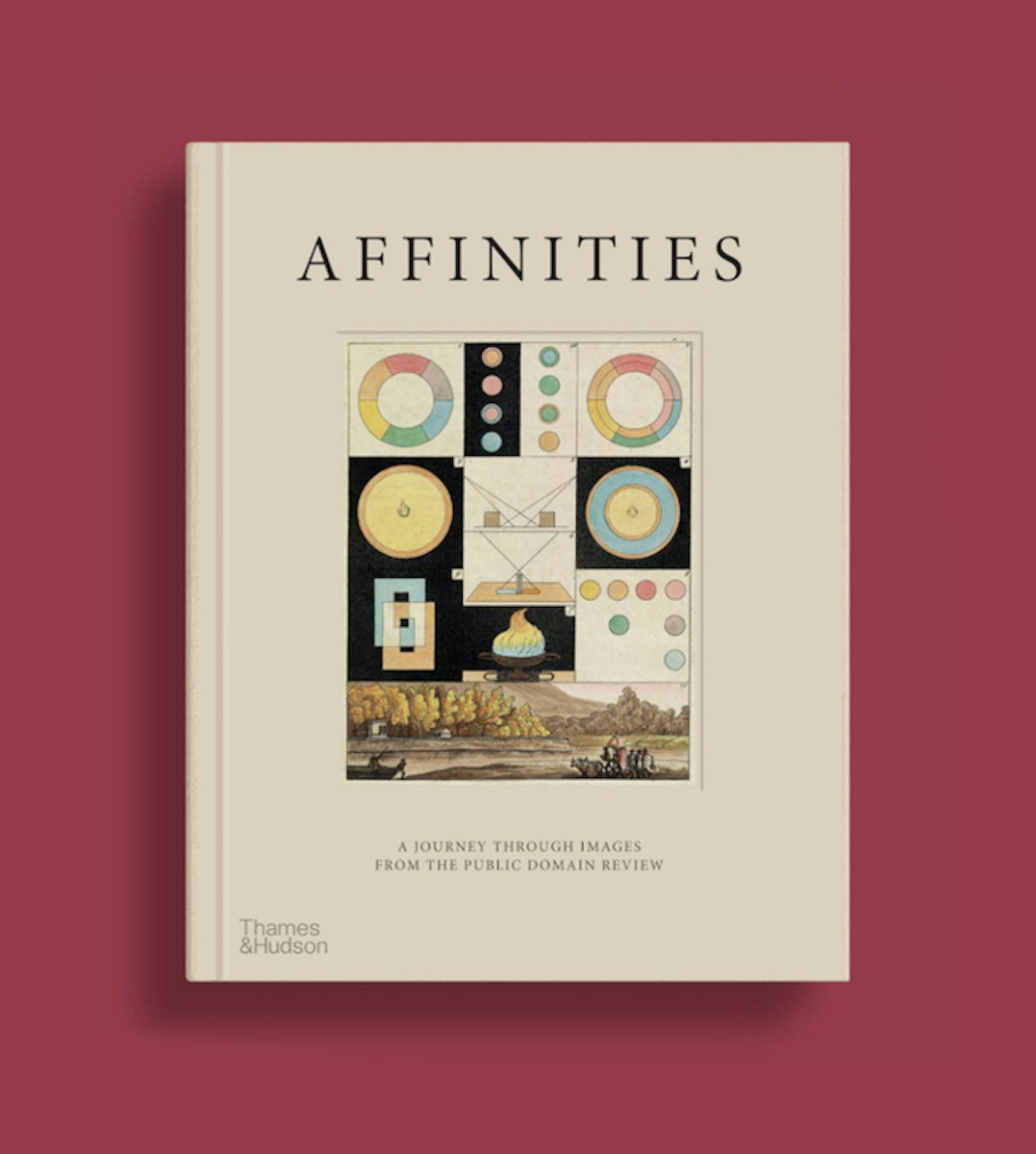
Greenland Unicorns and the Magical Alicorn
When the existence of unicorns, and the curative powers of the horns ascribed to them, began to be questioned, one Danish physician pushed back through curious means — by reframing the unicorn as an aquatic creature of the northern seas. Natalie Lawrence on a fascinating convergence of established folklore, nascent science, and pharmaceutical economy.
September 19, 2019
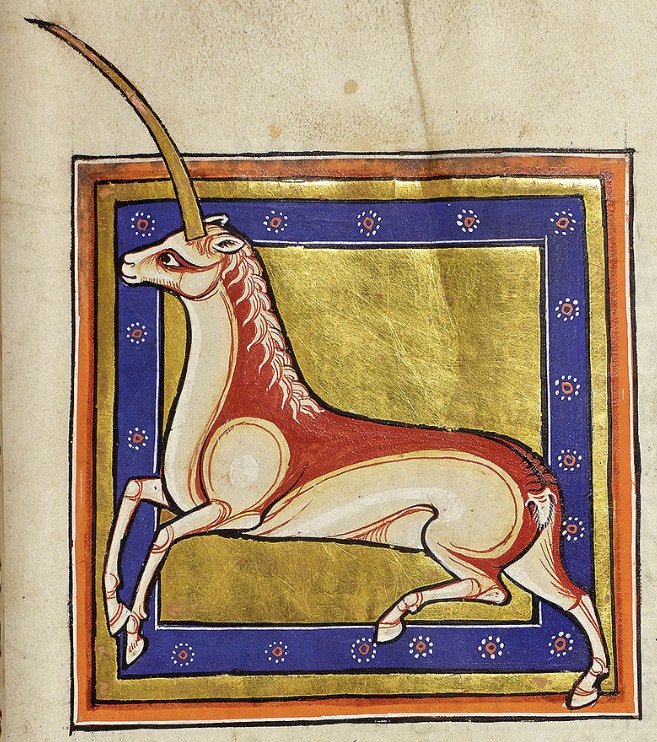 Scroll through the whole page to download all images before printing.
Scroll through the whole page to download all images before printing.Monoceros, a mythical beast first described in Pliny the Elder’s Natural History as a creature with the head of a stag, tail of a boar, elephant’s feet and a horse’s body — and from the head a horn four feet long — from the Aberdeen Bestiary (Ms 24, folio 15r), written and illuminated in England around 1200 — Source.
Unicorns seem to be everywhere these days. It’s virtually impossible to walk down a high street or go into a gift shop without coming face to face with one of these rainbow-spangled creatures in some form or other. They have become a fashionable cultural icon of fantasy, escapism, and (somewhat paradoxically) individuality — a fact exploited to the full by manufacturers and marketing experts. All the same, most people today are well aware unicorns don’t exist.
In the seventeenth century, the existence of the unicorn was a serious matter of contention. What was at stake was far more than the fantasy worlds of tweenage girls: this fantastical beast was the basis for a whole body of scholarly literature and a lucrative international market in pharmaceuticals (both recreational and medicinal). As Professor Bernd Roling shows in his 2014 essay “Der wal als schauobjekt”, one family in particular were responsible for the demise of the unicorn’s long-standing market value in Europe.1 Caspar Bartholin, his brother-in-law Ole Worm, and his son Thomas Bartholin were a trio of Scandinavian scholars and physicians who scrutinized the unicorn and its purported medicinal powers. Their work culminated in the publication of Thomas Bartholin’s De Unicornu Observationes Novae (New observations about the unicorn) in 1645 (second edition in 1678). Quite counter to Thomas’ intentions, this book precipitated the shunting of the unicorn from credible reality into myth.
De Unicornu Observationes Novae dealt with “unicorns” in the broadest sense, examining all animals with a single horn. Thomas cast his net wide because he was attempting to undertake a very important task: to prove that simply having a single horn didn’t qualify something as a unicorn. He wanted to show that “real” unicorns did exist and that their horns were a key ingredient for many potent medicines. In doing so, though, he had to replace the traditional European image of unicorns as terrestrial antelopes or horses that inhabited exotic Eastern wilds by demonstrating that unicorns were actually aquatic creatures from the North.
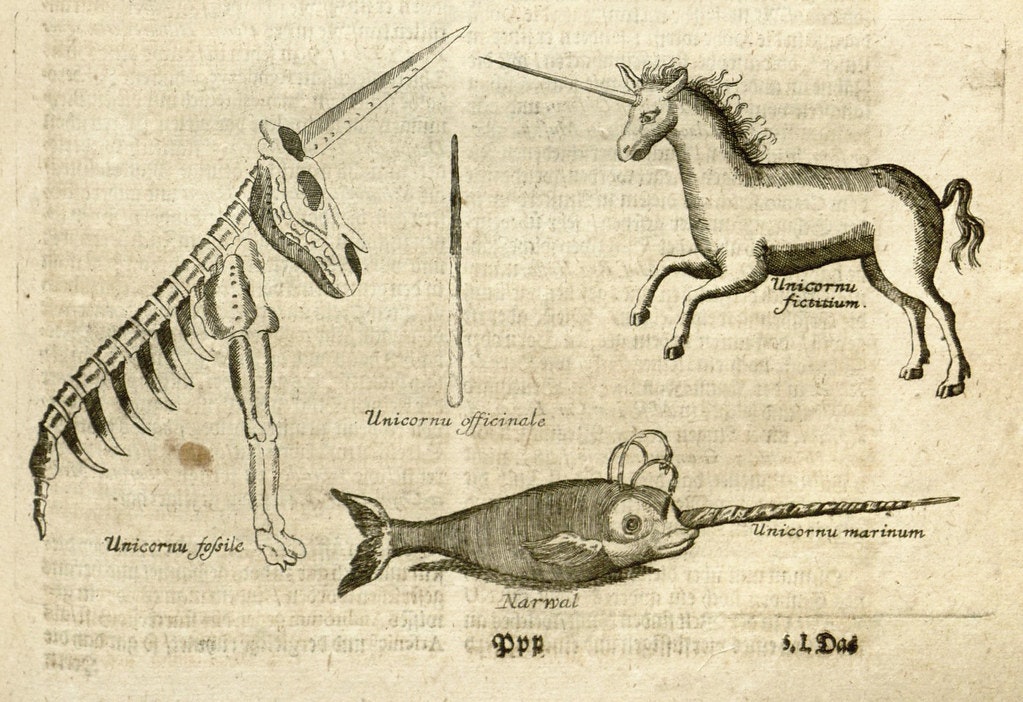 Scroll through the whole page to download all images before printing.
Scroll through the whole page to download all images before printing.Unicorn and narwhal side by side, from Michael Bernhard Valentini’s Museum Museorum (1704) — Source.
Why did Thomas Bartholin feel the need to make this point? Let’s first take a look at why unicorns were so important in early modern Europe. By the seventeenth century, they had a long history already: medieval scholars had assembled descriptions of “unicorns” by classical authors such as Ctesias, Aelian, Aristotle, and Pliny into a body of unicorn lore. These descriptions were of many and varied animals, from inelegant rhino-like beasts with a temper and a penchant for bullying elephants to strangely colourful antelope or fierce chimaeras. The Greek physician Ctesias, for example, recorded exotic travellers’ tales in his book Indica (ca. 810–893 AD), which contains perhaps the earliest surviving account of unicorns:
There are in India certain wild asses which are as large as horses, and larger. Their bodies are white, their heads dark red, and their eyes dark blue. They have a horn on the forehead which is about a foot and a half in length.2
The horn, Ctesias added, was said to be white, red, and black, and offered protection against poison. Most other classical authors were probably also referring to animals they had seen or heard about from travellers (though some might have been rather more creative with their material). What unified accounts of these varied “unicorns” was the idea that they were beasts of great power with a single horn on their heads.
The image of the unicorn was transfigured throughout the Middle Ages — by the sixth-century scholar Isidore of Seville, among others — into a wild, one-horned horse that could be killed by hunters only if it was first lured in and tamed by a virgin. Stories of this kind were recorded in bestiaries and collections of lore such as the Physiologus, which was added to, translated, and reproduced over many centuries. Some versions of the Physiologus included tales of unicorns dipping their horns into water that had been poisoned by serpents, in order to purify it.
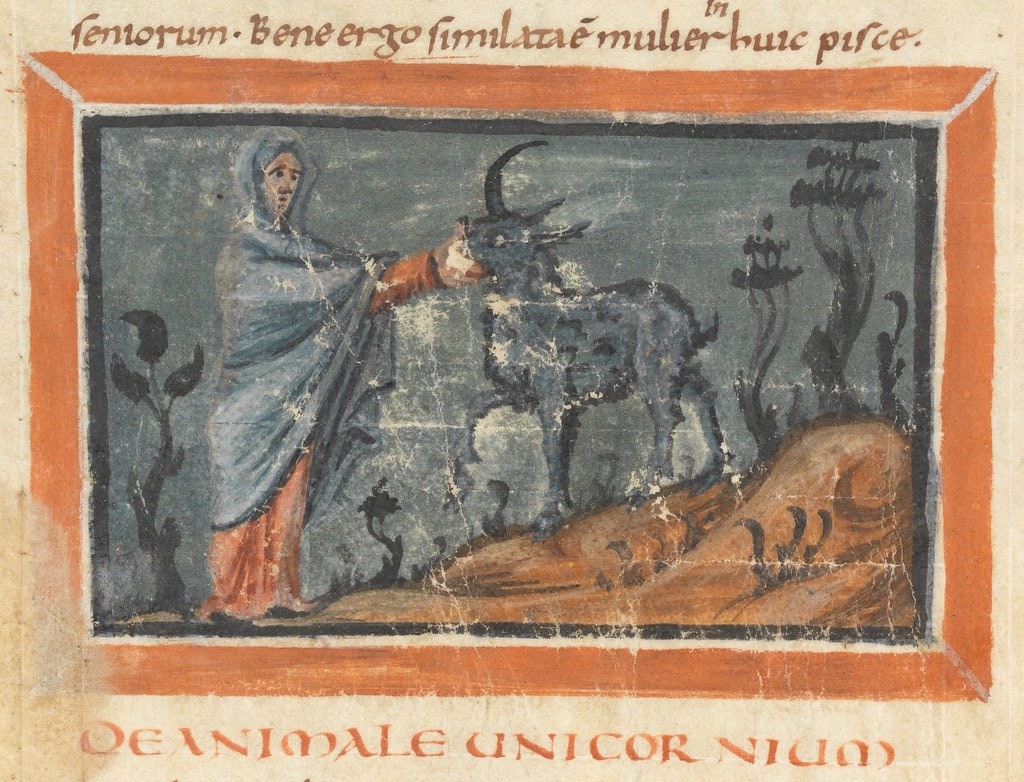 Scroll through the whole page to download all images before printing.
Scroll through the whole page to download all images before printing.Virgin taming a unicorn, from the Physiologus Bernensis, a 9th-century illuminated copy of the Latin translation of the Physiologus (Bern Cod. 318) — Source.
This fabulous horse, his magical abilities, and his maiden temptress were enshrined in the sequence of seven unicorn tapestries thought to have been made at the turn of the sixteenth century (now on permanent display at the Met Cloisters in New York). By the early modern era, the unicorn had become a Christian symbol. The image of the beast slain by hunters was associated with Christ’s sacrifice and his noble submission to a virgin had come to represent the Virgin Mary’s chaste power.
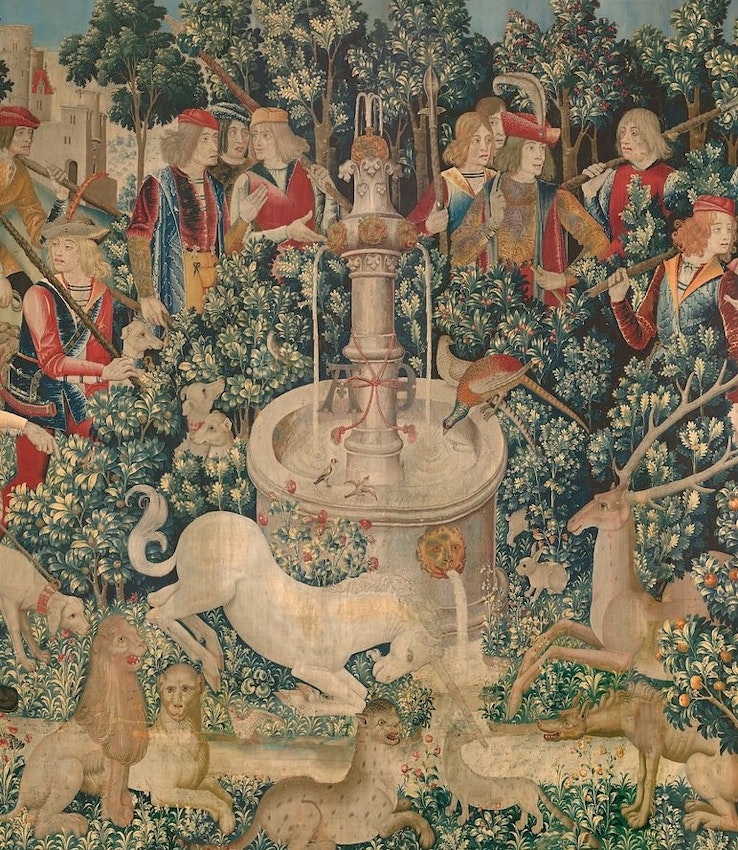 Scroll through the whole page to download all images before printing.
Scroll through the whole page to download all images before printing.Second of the Unicorn Tapestries, the unicorn shown dipping its purifying horn into the water, while around the hunting party stands and talks — Source.
Such exotic and sacred associations helped gain unicorn horn or “alicorn” a reputation as a panacea in Europe. Nobles had long had tableware supposedly made of alicorn to avoid being bumped off by poison in their food and drink. Powder made from the horn was similarly believed to cure a case of poisoning. Alicorn was also considered a powerful aphrodisiac and an effective treatment for all sorts of ailments, from fever to the aches of old age.
In the decades before Thomas Bartholin published De Unicornu Observationes Novae, there was still a roaring trade in powdered “unicorn horn” bolstered by classical texts and biblical imagery, as well as by more recent scholarly works singing the praises and potencies of the horn. Apothecaries in some areas displayed unicorn images or actual specimens of horns to signal that they had access to these costly and potent substances. The spiralling tusks of narwhals, identified by dealers, collectors, and scholars as alicorns, were prized possessions in many cabinets of wonder around early modern Europe.
The powdered horn, sold at a premium by apothecaries, was usually made from narwhal tusk, traded to Europe through Scandinavia, which profited greatly from the trade. The horn could also have other sources, including elephant or walrus tusk. Some experts could tell ivories apart: one apothecary argued that narwhal “Horn . . . may be distinguished from [elephant] Ivory by the threads or fibres which are more subtle” and in being “more solid and more heavy”.3 Chopped up into chunks, or ground down completely, however, few people except the hunters and dealers knew where the horns really came from. This confusion was occasionally lamented by writers and apothecaries. The well-travelled French doctor Pierre Martin de La Martinière (1634–1690), for example, commented upon the difficulty of knowing “the right Unicorn . . . there being several Animals the Greeks call Monoceros, and the Latines Uni-Cornis”, ranging from myriad terrestrial quadrupeds and “serpents”, to “fish” such as the “sea elephant”.4
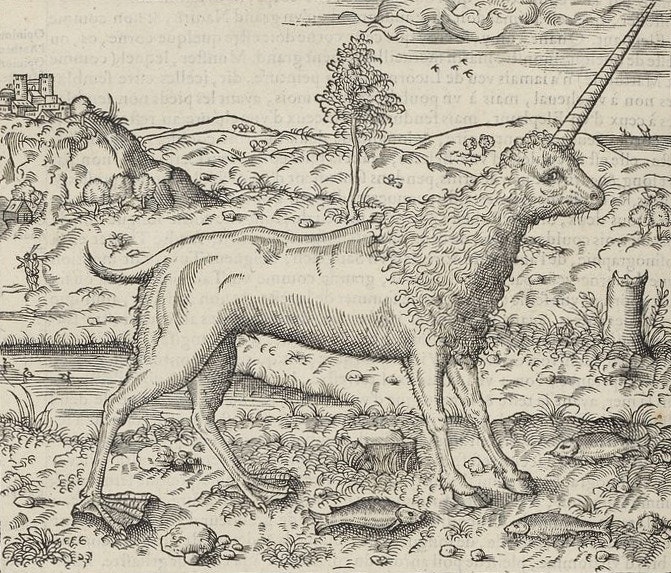 Scroll through the whole page to download all images before printing.
Scroll through the whole page to download all images before printing.Depiction of a “camphur”, from Ambroise Paré’s Des monstres et prodiges (1585). This mythical unicorn-like beast was amphibious (note the webbed feet and fish) and said to live in Indonesia — Source.
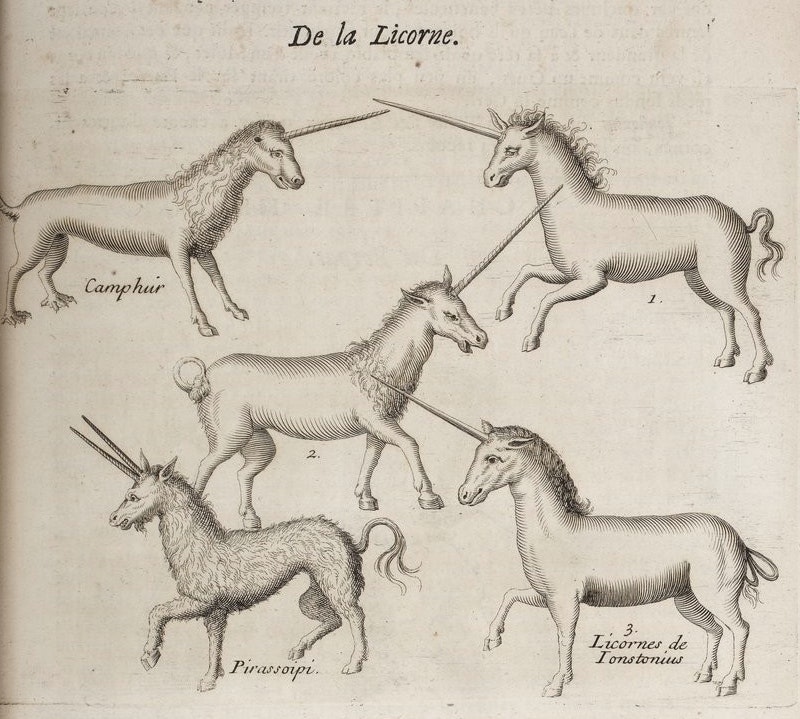 Scroll through the whole page to download all images before printing.
Scroll through the whole page to download all images before printing.Various types of terrestrial unicorn (including the amphibious “camphur” top left), from Pierre Pomet’s Histoire générale des drogues (1694) — Source.
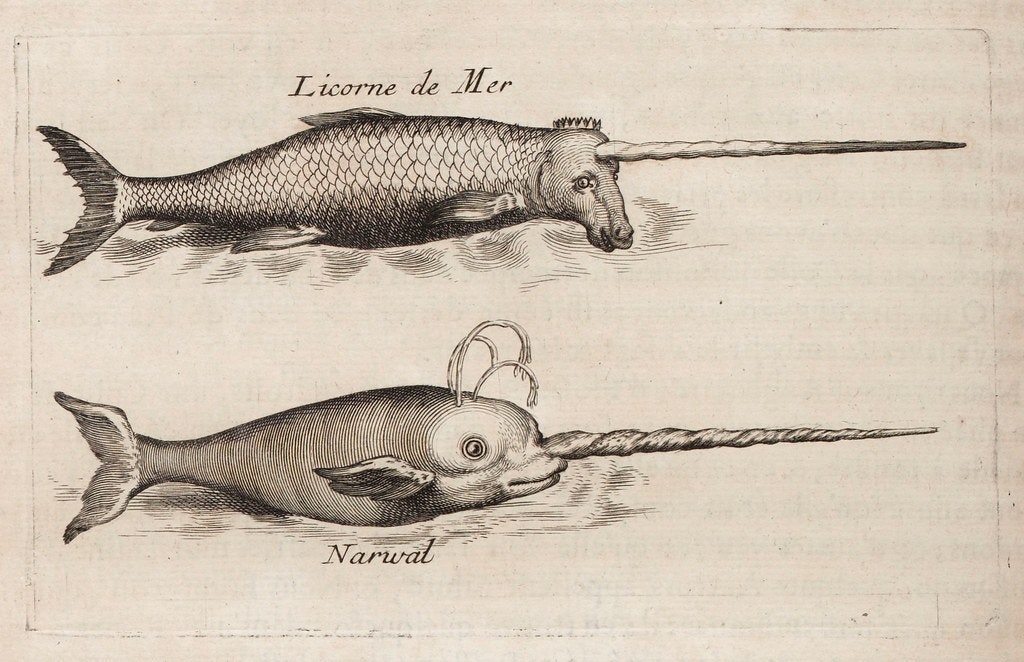 Scroll through the whole page to download all images before printing.
Scroll through the whole page to download all images before printing.Licorne de mer (sea unicorn) and a narwhal depicted as two distinct animals, from Pierre Pomet’s Histoire générale des drogues (1694) — Source.
People weren’t entirely lacking in scepticism, though. Many had their suspicions regarding the reality of the unicorn and the power of the horn. The French physician Ambroise Paré’s Des monstres et prodiges (1585) contained a “Discourse on the Unicorn” discussing his doubts. Europeans’ explorations in the Arctic throughout the sixteenth and seventeenth centuries revealed that the narwhal, a strange spear-headed fish which was previously unknown in European scholarship, was the source of some of these “unicorn” horns. After the first formal European description of the narwhal was produced by William Baffin in the late sixteenth century, the medicinal value of alicorn started to be called into question. Many kinds of horn-like products were thought to contain magical properties — some texts claimed that walrus tusk was even more powerful than alicorn. Such comparisons further threatened the elevated status of alicorn as questions about its origins tarnished its allure. Scholars in Southern Europe began to question whether “unicorn horn” was really all it had been cracked up to be.
Enter the Bartholins. Beginning in 1613, Thomas’ father, Caspar Bartholin the Elder, was the professor of medicine at the University of Copenhagen in Denmark. Before taking this post, he had travelled extensively through the Netherlands, England, France, and Germany — which was relatively unusual at that time. On his travels, he visited some of Europe’s most illustrious Wunderkammern, or cabinets of wonders. Examining the unicorn horns present in these collections, he concluded they could not be antelope- or horse-derived appendages. They must be marine. Coming from Denmark, Caspar was far too familiar with the narwhal not to have noticed the similarity between their horns and alicorns, but he avoided making a direct link between them.
It wasn’t until 1636 that Caspar’s brother-in-law, the prolific antiquary and collector Ole Worm, affirmed that narwhals were indeed the source of alicorn. By systematically comparing the skeletons of narwhals with the twisted ivory horns sold as unicorn horns in Europe, he proved they were one and the same: alicorns could only be the bizarre, single emergent teeth of the marine animals. Ole’s conclusion created all sorts of problems. What had the classical authors been describing? Did terrestrial unicorns exist? Was alicorn actually medically potent?
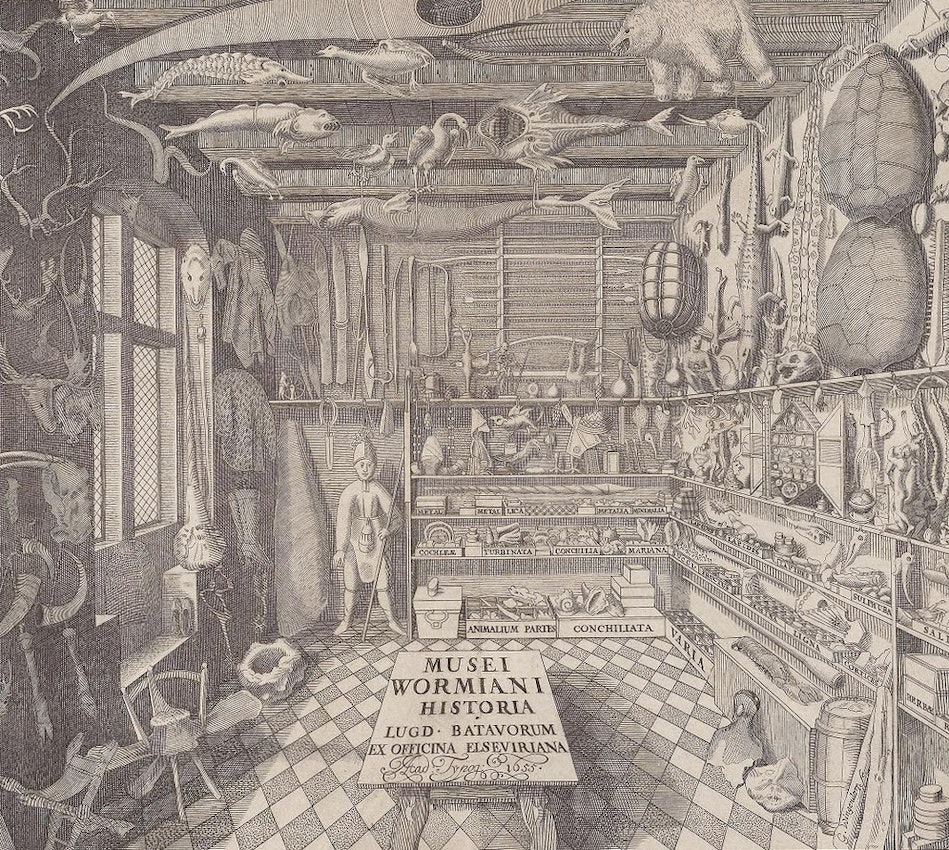 Scroll through the whole page to download all images before printing.
Scroll through the whole page to download all images before printing.Ole Worm’s cabinet of curiosities, as pictured in his Museum Wormianum — Source.
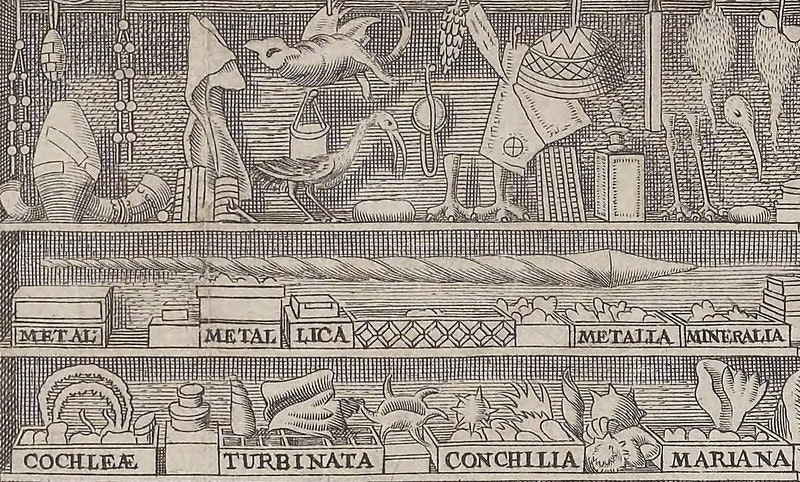 Scroll through the whole page to download all images before printing.
Scroll through the whole page to download all images before printing.Detail from the image above, showing what looks to be a narwhal horn on the back wall.
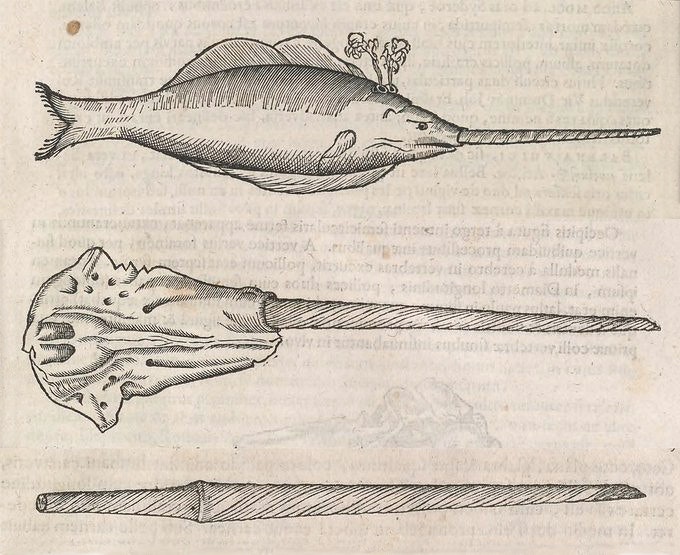 Scroll through the whole page to download all images before printing.
Scroll through the whole page to download all images before printing.Composite image showing three illustrations of the narwhal and horn, from Ole Worm’s Museum Wormianum — Source.
Thomas Bartholin, who was a physician by training, stepped in to resolve the quandaries left by his father and uncle’s investigations. He also managed to execute some clever marketing and public relations for Denmark’s fishing industry. His work bridged the traditional scholarly penchant for prioritising the authority of ancient texts with the growing trend of using experiment and direct observation. He synthesised Caspar and Ole’s conclusions in De Unicornu Observationes Novae, reaffirming that alicorns were the tusks of narwhals while continuing to insist on their medicinal potency. In a sense it was a rebranding exercise: the humble narwhal, its magical properties affirmed, now reimagined as the “Greenland Unicorn”.
Written in Latin, Bartholin’s book laboriously analysed all of the known horned creatures, from rhinos to rhinoceros beetles, hornbills to horned vipers. Bartholin even touched on a few man-made horn objects, such as the “Horn of Gallehus”, a piece of fifth-century craftsmanship made of pure gold, found in Denmark in 1639. (All of these creatures and objects were elaborately illustrated, with full fold-out images in the later 1678 edition produced by Thomas’ son, who was, like his grandfather, called Caspar.)
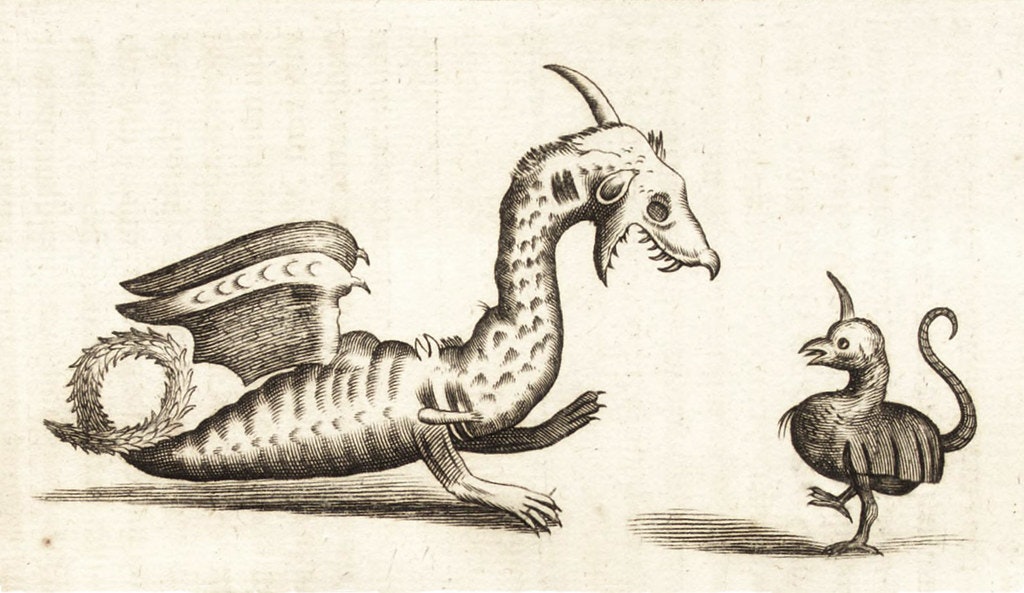 Scroll through the whole page to download all images before printing.
Scroll through the whole page to download all images before printing.Illustration of uni-horned creatures, from the 1678 edition of Thomas Bartholin’s De Unicornu Observationes Novae — Source.
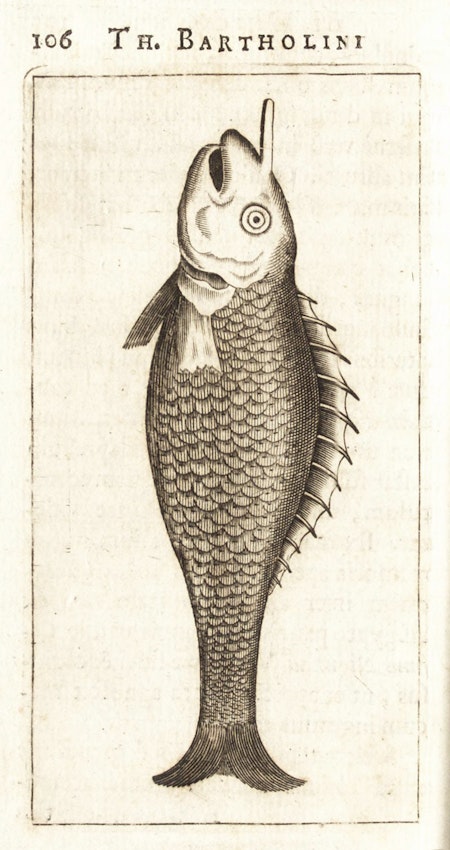 Scroll through the whole page to download all images before printing.
Scroll through the whole page to download all images before printing.Illustration of a narwhal-like creature, from the 1678 edition of Thomas Bartholin’s De Unicornu Observationes Novae — Source.
Given that the usual classical authorities were focused on the land-based versions of the mythical beast, Bartholin called upon some very different ancient sources to give his work gravitas. He used Old Norse texts such as the Konungs skuggsjá (King’s Mirror) — a text written in 1250 for the education of a young Norwegian prince — to demonstrate that the Norsemen were well aware of the nature of these horns and had known of their great power as they traded in them. Invoking the wisdom of such an old text was a powerful argument in a world where tradition and ancient knowledge were put on a pedestal.
In addition to scouring the written record, Thomas also conducted a series of experiments in the hope of confirming the efficacy of narwhal/unicorn horn for curing ailments. Roling mentions that Thomas “even thought he was able to halt a fever epidemic in Copenhagen with unicorn rubs”.5 Using such hard observational evidence to prove that alicorn really was a powerful medicine, he quelled the growing arguments to the contrary. Finally, Thomas was willing to concede that the terrestrial unicorns mentioned in ancient texts must have real-life counterparts in exotic locales; but the medicinal, potent, and valuable alicorn? Well, that could only be procured from the Arctic marine mammals. And only from Iceland.
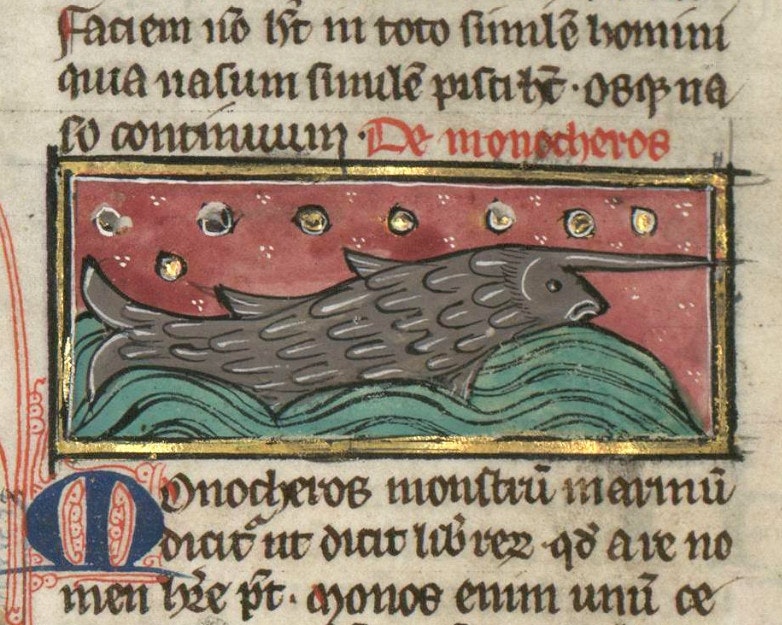 Scroll through the whole page to download all images before printing.
Scroll through the whole page to download all images before printing.“Monocheros”, from Thomas Cantimpré’s Liber de natura rerum (ca. 1280) — Source.
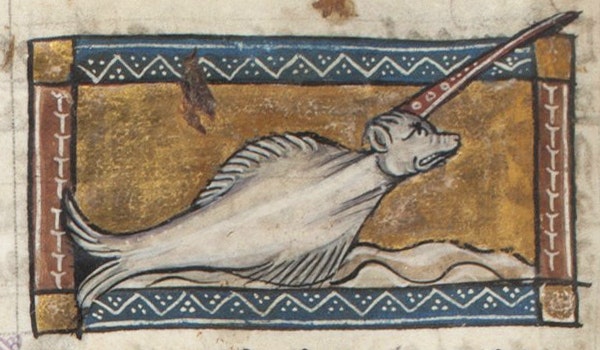 Scroll through the whole page to download all images before printing.
Scroll through the whole page to download all images before printing.“Monocheros”, from Jacob van Maerlant’s Der naturen bloeme (ca. 1350) — Source.
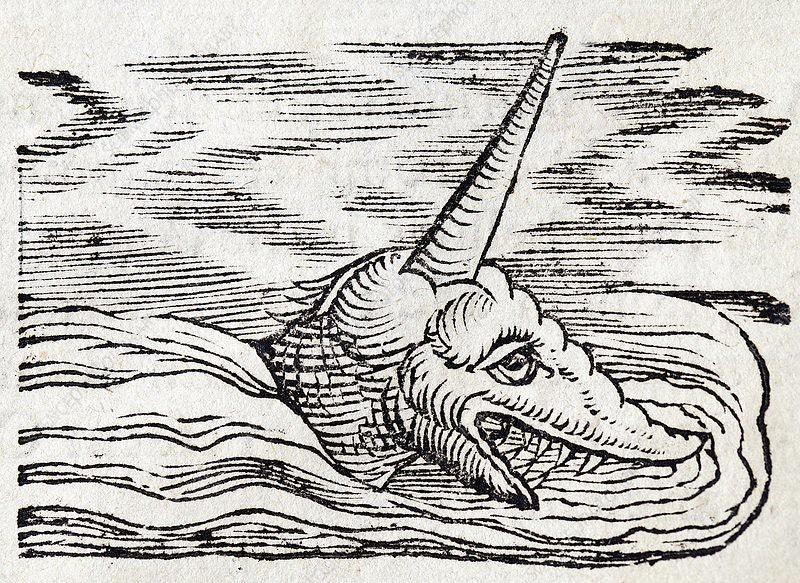 Scroll through the whole page to download all images before printing.
Scroll through the whole page to download all images before printing.Narwhal, or “sea unicorn”, from Conrad Gesner’s, Historia animalium (1558) — Source.
Thomas Bartholin’s reimagining of the narwhal as the “sea unicorn” was an important marketing gimmick. It protected the value of a medicine that the Bartholins, as physicians, could continue to administer at great cost to their patients. At the same time, it protected the valuable Scandinavian trade in narwhal horns, which was important to the Danish economy. The 1678 publication of an elaborately illustrated edition of De Unicornu by Thomas’ son, Caspar, helped to maintain the sea unicorn’s image in the public eye, and for decades after, Thomas’ ideas continued to have a place in scholarly discussions of alicorn.
This shift from terrestrial horse to sea beast is one of the many changes the meaning of “unicorn” has undergone over time. For a short while in the seventeenth century, the “Greenland Unicorn” — a strange northern sea creature that few Europeans had seen — displaced their obscure hoofed cousins in Asia as the source of the wonderful, spiralling tusks valued by collectors and physicians. Thomas Bartholin’s sleight of hand maintained popular faith in the potency of alicorn until the early eighteenth century, when pharmacists became disenchanted. More reliable experiments proved the powder was not all that useful for curing disease or protecting against poison. In his Systema Naturae (1735), the most prominent taxonomist in history, Carl Linnaeus, would reject the “Greenland Unicorn” once and for all (though the narwhal’s scientific name remains Unicornu groenlandicus). Still, there was a time when unicorns existed both in the sea and on the land, before the medicinal magic of their horns was dispelled and they retreated to the world of pure fable.
Natalie Lawrence is a writer, researcher, and illustrator living in London. She has a MCantab in natural sciences and PhD in the history and philosophy of science from the University of Cambridge. She recently published Planta Sapiens: Unmasking Plant Intelligence (2022, Bridge Street Press) with Paco Calvo and her book The Nature of the Beast (Orion Books), on the history of monstrous creatures and the imagination, will be out in 2023.
Imagery from this post is featured in
Affinities
our special book of images created to celebrate 10 years of The Public Domain Review.
500+ images – 368 pages
Large format – Hardcover with inset image





